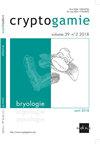Morphological and Molecular Evidence for Synonymy of Cinclidotus confertus Lüth with C. riparius (Host ex Brid.) Arn.
IF 0.9
3区 生物学
Q4 PLANT SCIENCES
引用次数: 4
Abstract
ABSTRACT Cinclidotus confertus Lüth was described in 2002 from Greece and has to date only been recorded from the type locality. The taxon was supposed to differ from the widespread C. riparius (Host ex Brid.) Arn. in the red and papillose peristome teeth, as opposed to yellow and smooth peristome teeth of C. riparius. However, we found that the peristome of C. riparius was inconsistently described in the bryological literature, with some authors admitting reddish and papillose peristome teeth as well. To clarify the peristome characteristics of C. riparius and the taxonomic identity of C. confertus we studied both taxa morphologically and molecularly. Sporophyte characteristics of C. riparius are variable, but most specimens have red and papillose peristome teeth, and no other morphological difference could be found between plants assigned to C. confertus and C. riparius. The many erroneous or incomplete descriptions of the peristome characteristics of C. riparius may be related to the fact that in central Europe sporophytes are rarely produced and that the fragile peristome easily erodes. Furthermore, the phylogenetic analysis of chloroplast rps4 and nuclear ITS2 loci failed to segregate specimens assigned to C. riparius from those assigned to C. confertus, including material from the type locality and further newly discovered localities of the latter taxon. Consequently, we propose the synonymy of both taxa.长尾蠓(ccliniddotus contus l th)与riparius同义的形态学和分子证据(寄主前杂交)在攻击。
cclinlidotus conftus l于2002年在希腊被描述,迄今为止仅在模式地点有记录。该分类群被认为不同于广泛分布的C. riparius (Host ex Brid.)。在攻击。在红色和乳头状的壁壁牙中,相对于黄色和光滑的河滨草的壁壁牙。然而,我们发现,在苔藓学文献中,对河鼠胃壁的描述并不一致,一些作者也承认其胃壁有红色和乳头状的牙齿。为进一步阐明河青的肠壁特征和河青的分类特性,从形态学和分子生物学两方面对河青进行了研究。河青的孢子体特征各不相同,但大多数标本具有红色和乳突状的壁壁齿,在其他形态上没有发现河青与河青的区别。关于河柳叶枯壁特征的许多错误或不完整的描述可能与中欧很少产生孢子体和脆弱的枯壁容易被侵蚀有关。此外,叶绿体rps4和核ITS2基因座的系统发育分析也无法区分出河青(C. riparius)和孔丘(C. contus)的标本,包括来自模式地的材料和新发现的孔丘的材料。因此,我们提出这两个分类群的同义词。
本文章由计算机程序翻译,如有差异,请以英文原文为准。
求助全文
约1分钟内获得全文
求助全文
来源期刊

Cryptogamie Bryologie
生物-植物科学
CiteScore
2.10
自引率
25.00%
发文量
12
审稿时长
3 months
期刊介绍:
Cryptogamie is a fully electronic journal, with a continuous
publication stream, devoted to a wide diversity of cryptogamic
topics, mainly in the taxonomic-phylogenetic field.
Cryptogamie, Bryologie accepts articles on systematics as
well as ecology and evolution of all of bryophytes.
Thematic issues may also be published under the responsibility of a guest editor.
 求助内容:
求助内容: 应助结果提醒方式:
应助结果提醒方式:


